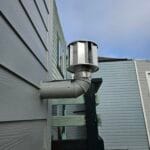Imagine reaching for a refreshing drink on a hot day, only to find that your fridge isn’t as cold as it should be, while the freezer still works like a charm. Frustrating, isn’t it?
You’re not alone. Many people face this puzzling issue. It’s more than just an inconvenience; it could mean spoiled food and wasted energy. But before you panic, let’s explore what might be going wrong inside your fridge. By understanding the possible reasons, you can save time, money, and avoid unnecessary stress.
Stick around, because the solution might be simpler than you think!

Credit: m.youtube.com
Common Causes Of Fridge Cooling Issues
Opening the fridge to find warm milk but frozen peas can be frustrating. This common dilemma is often due to a few key issues. Understanding these problems can help you fix them without professional help. Here are some common causes of fridge cooling issues.
Faulty Thermostat
The thermostat controls the fridge temperature. If it’s faulty, the fridge won’t cool properly. Sometimes, the thermostat might be set incorrectly. It can also wear out or break. A simple test is to adjust the thermostat setting. If the cooling doesn’t improve, consider replacing it.
Blocked Air Vents
Air vents circulate cold air from the freezer to the fridge. When these vents are blocked, the fridge becomes warm. Items stored too close can obstruct airflow. Check for ice buildup or food blocking the vents. Clear these obstructions for better air circulation.
Malfunctioning Evaporator Fan
The evaporator fan helps distribute cold air. If it fails, the fridge compartment won’t cool. Listen for unusual noises from the fan area. No sound might indicate a problem. A broken fan might need a replacement to restore cooling efficiency.
Freezer Working, Fridge Not: Key Differences
Experiencing a cold freezer but a warm fridge can be baffling. Understanding the key differences between these compartments can help identify the problem. Both sections serve unique purposes, yet their cooling mechanisms often differ.
Separate Cooling Systems
Many modern fridges have dual cooling systems. This means the freezer and fridge operate independently. The freezer may cool effectively while the fridge struggles. Separate systems allow the freezer to maintain low temperatures, even if the fridge fails. A malfunction in one system doesn’t always affect the other.
Frost Build-up Impact
Frost can build up in the freezer. This can block the airflow to the fridge section. When air circulation is hindered, the fridge loses its cooling ability. Regular defrosting can prevent this issue. Excess frost impacts the fridge’s performance more than the freezer’s.
Diagnosing The Problem
Is your fridge warm but the freezer remains cold? This issue can be frustrating. Identifying the cause is crucial for a quick fix. Several components might be responsible. Let’s explore the diagnostic steps.
Checking Temperature Settings
Start with the temperature settings. Ensure they are set correctly. The fridge temperature should be between 37-40°F. The freezer should be around 0°F. Adjust if needed. Sometimes settings get changed accidentally.
Inspecting Door Seals
Door seals play a vital role. They keep cold air inside. Check for cracks or gaps in the seals. A simple visual inspection can reveal issues. Feel for cold air escaping. Replace damaged seals promptly.
Examining The Condenser Coils
Condenser coils are essential for cooling. Locate them at the back or bottom of your appliance. Dust and dirt can accumulate, reducing efficiency. Clean the coils regularly. Use a brush or vacuum cleaner for best results.

Credit: www.dependableservices.com
Diy Fixes For Fridge Issues
Is your fridge warm while the freezer remains icy cold? This common issue can be frustrating. Fortunately, many fridge problems have simple DIY solutions. You might not need to call a repair service just yet. With basic tools and a little effort, you can tackle the problem. Here are some easy fixes to try at home.
Cleaning The Coils
Dusty coils can cause cooling issues. First, unplug your fridge. Locate the coils, usually at the back or underneath. Use a vacuum or coil brush to remove dust and dirt. Clean coils help the fridge run efficiently. This can improve overall cooling.
Adjusting The Thermostat
A misadjusted thermostat can affect cooling. Check the settings inside your fridge. Make sure it’s set to the recommended temperature. Usually, this is between 37°F to 40°F. Adjust the dial if needed and wait a few hours. Your fridge should start cooling better.
Clearing The Air Vents
Blocked air vents can disrupt airflow. Inspect the vents inside your fridge. Make sure food items aren’t blocking them. Space out items to allow air circulation. This helps maintain a consistent temperature. Proper airflow is key for efficient cooling.
When To Call A Professional
Experiencing a fridge that isn’t cold but a working freezer often signals a problem with the thermostat or airflow. Strange noises or frost buildup can indicate a need for professional help. Calling a technician ensures accurate diagnosis and repair, preventing further damage.
When your fridge isn’t keeping things cold but the freezer is working fine, it might be time to call in a professional. While some issues can be tackled with a quick DIY fix, others require the expertise of a trained technician. But how do you know when it’s time to make that call?Identifying Severe Problems
If you notice frost build-up in the freezer or a persistent buzzing noise, it’s a sign of a severe problem. These issues often indicate a failing compressor or malfunctioning evaporator fan. A professional can diagnose these complex problems accurately, saving you time and money in the long run. Sometimes, you’ll find water pooling at the bottom of your fridge. While a blocked defrost drain could be the culprit, it might also mean a deeper issue. An expert can determine the root cause and fix it effectively.Understanding Repair Costs
Before calling a professional, it’s helpful to understand what the repairs might cost. Simple issues like thermostat replacement are usually inexpensive. However, more severe problems, such as a faulty compressor, can be costly. Consider the age of your fridge as well. If it’s old, investing in a new model might be more cost-effective. A professional can provide an estimate, allowing you to make an informed decision. Have you ever thought about what goes into calculating these costs? It’s not just the parts but also the labor and time involved. Knowing this can help you better prepare for the financial aspect of repairs. When you’re faced with a fridge that’s not cooling, ask yourself: Is it worth the DIY risk, or is it time to call in the pros? Knowing when to seek help can prevent small issues from becoming major headaches.Preventive Maintenance Tips
Fridge cooling problems often arise from blocked vents or a malfunctioning thermostat. Check for ice build-up in the freezer. Regularly clean coils and ensure the door seals tightly for efficient cooling. Proper maintenance can prevent these issues and keep your appliance running smoothly.
Keeping your fridge running smoothly requires some attention and care, especially if you want to avoid the annoying issue of a warm fridge and a cold freezer. Understanding preventive maintenance can save you from future headaches and costly repairs. Let’s dive into some simple yet effective tips to ensure your refrigerator functions properly and keeps your food fresh.Regular Cleaning Routine
First things first, keep your fridge clean. Dust and grime can accumulate on the coils at the back of your fridge. This makes it harder for your appliance to cool efficiently. Make it a habit to clean these coils every six months. Use a vacuum or a brush to remove dust. This simple act can significantly improve your fridge’s performance and save on energy bills.Proper Loading Of Items
How you load your fridge matters. Overstuffing can block air vents, causing uneven cooling. Leave enough space between items to allow air to circulate freely. Think about the last time you organized your fridge. Were items crammed together? Consider using bins or baskets for better organization and airflow. Your fridge will thank you.Maintaining Optimal Temperature
Setting the right temperature is crucial. Keep your fridge between 37°F and 40°F, and your freezer at 0°F. These settings ensure food safety and energy efficiency. Have you ever checked the temperature settings in your fridge? If not, now might be a good time. Use a thermometer to verify and adjust if needed. By following these preventive maintenance tips, you can keep your fridge and freezer running smoothly. What other tricks do you have up your sleeve for maintaining your appliances? Share your thoughts and let’s keep the conversation going!
Credit: www.dependableservices.com
Frequently Asked Questions
Why Is My Fridge Warm But The Freezer Cold?
The fridge and freezer have separate cooling systems. A blocked vent can cause the fridge to warm up.
How Can I Fix A Warm Fridge Compartment?
Check for blocked vents, dirty coils, or faulty thermostats. Ensure the fridge door seals tightly.
Could A Broken Fan Affect Fridge Cooling?
Yes, a broken fan can stop cool air circulation. This keeps the fridge warm while the freezer stays cold.
What Role Does The Thermostat Play In Cooling?
The thermostat regulates temperature. If malfunctioning, it can cause cooling issues in the fridge compartment.
Can Ice Buildup Impact Fridge Cooling?
Yes, ice can block vents and disrupt airflow. Regularly defrost to maintain efficient cooling.
Conclusion
A warm fridge with a cold freezer can be puzzling. Common causes include blocked vents or faulty thermostats. Check for ice build-up in the fridge. It might block air flow. Clean the condenser coils regularly. Dirty coils reduce cooling efficiency.
Ensure the door seals tightly. Loose seals let cold air escape. If problems persist, contact a professional. It might need expert attention. Regular maintenance keeps your fridge running smoothly. Stay proactive to avoid future issues. Keep your food fresh and safe.
Understanding these basics helps maintain your appliance. A little care goes a long way.




